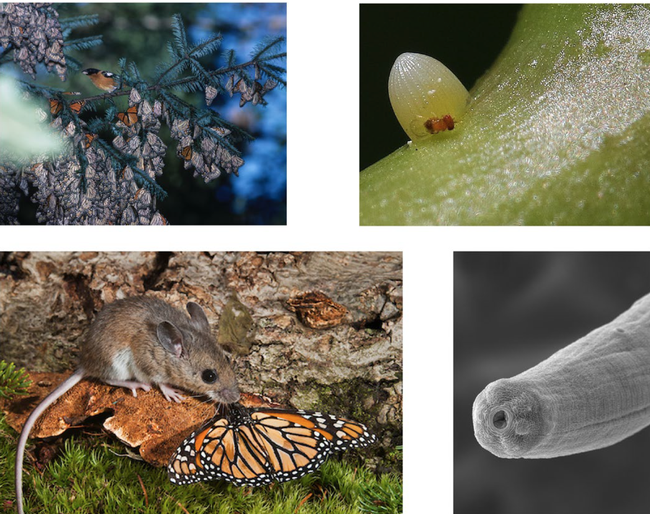"Scientists now understand how certain animals can feed on picturesque, orange monarch butterflies, which are filled from head to abdomen with milkweed plant toxins.
"In high enough concentrations, milkweed can kill a horse, or a human. To be able to eat this plant, monarchs evolved a set of unusual cellular mutations. New UC Riverside research shows the animals that prey on monarchs also evolved these same mutations.
"A Current Biology journal article, published Nov. 22, 2021, describes the research that revealed these mutations in four types of monarch predators — a bird, a mouse, a parasitic wasp, and a worm." --EurekAlert.
The leading author of that research article, evolutionary biologist Simon "Niels" Groen, an assistant professor at UC Riverside, will discuss "Plant Toxins and the Evolution of Host-Parasite Interactions" when he presents a seminar to the UC Davis Department of Entomology and Nematology at 4:10 p.m., Wednesday, Feb. 2 in 122 Briggs Hall.
He will speak in person. The lecture also will be broadcast simultaneously on Zoom. The Zoom link: https://ucdavis.zoom.us/j/99515291076.
"Plants interact with incredibly diverse groups of animals including plant-feeding insects and nematodes as well as their natural enemies," Groen says in this abstract. "These interactions are influenced by toxic defensive chemicals that plants make. In my talk, I will focus on how plants evolved variation in production of these defensive chemicals and how animal parasites in turn evolved mechanisms enabling them to handle such toxins."
Groen, who joined the UC Riverside faculty in July 2021 following his postdoctoral research position (2014 to 2021) in the Noah Whiteman laboratory, Department of Ecology and Evolutionary Biology, University of Arizona, focuses his research on "understanding molecular mechanisms of adaptation in the context of species interactions and fluctuating environmental conditions."
A native of the Netherlands, he received his bachelor's degree and masters degree in biology from Wageningen University, Netherlands, and his doctorate in plant sciences from the University of Cambridge, UK.
Groen served as a visiting researcher from 2007 to 2008 in the Department of Multi-Trophic Interactions, Netherlands Institute of Ecology, and as a visiting researcher from 2008 to 2012 in the Department of Organismic and Evolutionary Biology, Harvard University.
"Growing up in The Netherlands, I became fascinated with plants and their responses to ever-changing environmental conditions while working as a 'ziekzoeker' in tulip fields outside of school hours," he writes in an author profile on the American Society of Plant Biologists website. The site featured him as the first author of “Evolutionary Systems Biology Reveals Patterns of Rice Adaptation to Drought-Prone Agro-Ecosystems," published Nov. 15, 2021 in the journal Plant Cell.
"A 'ziekzoeker' looks for diseased plants and I searched in particular for variegated white and red tulips--the ones you'd recognize from a golden-age Dutch still life painting," Groen related. "I learned how these tulips are infected with an aphid-transmitted virus and during my PhD in the group of John Carr at the University of Cambridge, I would further investigate the molecular mechanisms of how virus infections would change plant interactions with aphids and pollinators. I was gripped by the role that plant defensive chemicals play in shaping species interactions and I continued to study these as a postdoc with Noah Whiteman at the University of Arizona and the University of California, Berkeley.'
On the author page, he chronicled his previous work on the interactions between milkweeds and the monarch butterfly "and found out how the monarch evolved resistance to the cardenolide toxins that milkweeds make. While this work mostly revolved around a single gene of large effect, typically several or many genes are involved in organisms' evolutionary responses. As a Gordon and Betty Moore Foundation fellow in the group of Michael Purugganan at New York University, I learned about the latest developments in evolutionary genomics and systems biology while investigating patterns of natural selection on gene expression in rice populations that we grew under wet and dry field conditions with our collaborators at the International Rice Research Institute in The Philippines."
"The current paper (Plant Cell) is a culmination of this research," Groen related. "We found that under field drought rice plants do not just respond to changes in water availability, but also to concomitant changes in abundance of soil microbes that they interact with. As assistant professor in the Department of Nematology at the University of California, Riverside, I will continue to study rice and milkweed as well as plants from the nightshade family and look at the complex evolutionary tug-of-war between these plants and parasitic nematodes. Combining laboratory and field experiments, we will zoom in on the central role that plant chemicals play by using approaches from evolutionary and systems biology like the ones we describe in our paper."
Nematologist Shahid Siddique, assistant professor in the Department of Entomology and Nematology, coordinates the winter quarter seminars. He may be reached at ssiddique@ucdavis.edu for any technical issues involving the Zoom connection.
Attached Images:

